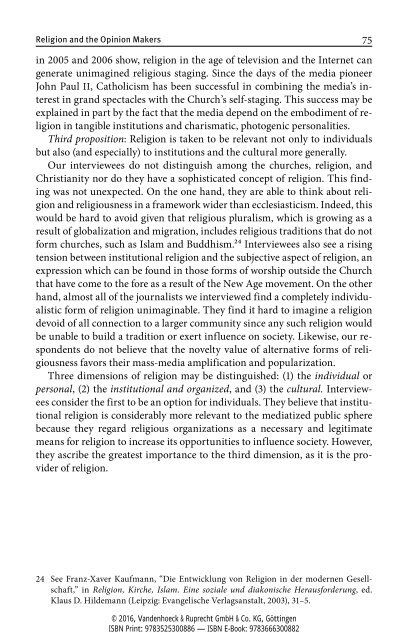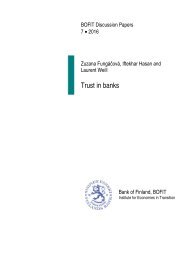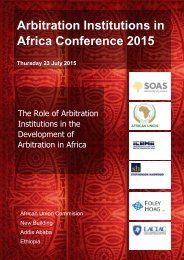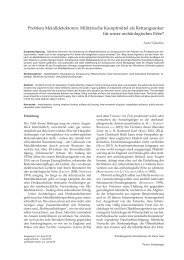Media and Minorities
9783666300882_ruhrmann_media_ebook_034247
9783666300882_ruhrmann_media_ebook_034247
You also want an ePaper? Increase the reach of your titles
YUMPU automatically turns print PDFs into web optimized ePapers that Google loves.
Religion <strong>and</strong> the Opinion Makers 75<br />
in 2005 <strong>and</strong> 2006 show, religion in the age of television <strong>and</strong> the Internet can<br />
generate unimagined religious staging. Since the days of the media pioneer<br />
John Paul II, Catholicism has been successful in combining the media’s interest<br />
in gr<strong>and</strong> spectacles with the Church’s self-staging. This success may be<br />
explained in part by the fact that the media depend on the embodiment of religion<br />
in tangible institutions <strong>and</strong> charismatic, photogenic personalities.<br />
Third proposition: Religion is taken to be relevant not only to individuals<br />
but also (<strong>and</strong> especially) to institutions <strong>and</strong> the cultural more generally.<br />
Our interviewees do not distinguish among the churches, religion, <strong>and</strong><br />
Christianity nor do they have a sophisticated concept of religion. This finding<br />
was not unexpected. On the one h<strong>and</strong>, they are able to think about religion<br />
<strong>and</strong> religiousness in a framework wider than ecclesiasticism. Indeed, this<br />
would be hard to avoid given that religious pluralism, which is growing as a<br />
result of globalization <strong>and</strong> migration, includes religious traditions that do not<br />
form churches, such as Islam <strong>and</strong> Buddhism.24 Interviewees also see a rising<br />
tension between institutional religion <strong>and</strong> the subjective aspect of religion, an<br />
expression which can be found in those forms of worship outside the Church<br />
that have come to the fore as a result of the New Age movement. On the other<br />
h<strong>and</strong>, almost all of the journalists we interviewed find a completely individualistic<br />
form of religion unimaginable. They find it hard to imagine a religion<br />
devoid of all connection to a larger community since any such religion would<br />
be unable to build a tradition or exert influence on society. Likewise, our respondents<br />
do not believe that the novelty value of alternative forms of religiousness<br />
favors their mass-media amplification <strong>and</strong> popularization.<br />
Three dimensions of religion may be distinguished: (1) the individual or<br />
personal, (2) the institutional <strong>and</strong> organized, <strong>and</strong> (3) the cultural. Interviewees<br />
consider the first to be an option for individuals. They believe that institutional<br />
religion is considerably more relevant to the mediatized public sphere<br />
because they regard religious organizations as a necessary <strong>and</strong> legitimate<br />
means for religion to increase its opportunities to influence society. However,<br />
they ascribe the greatest importance to the third dimension, as it is the provider<br />
of religion.<br />
24 See Franz-Xaver Kaufmann, “Die Entwicklung von Religion in der modernen Gesellschaft,”<br />
in Religion, Kirche, Islam. Eine soziale und diakonische Herausforderung, ed.<br />
Klaus D. Hildemann (Leipzig: Evangelische Verlagsanstalt, 2003), 31–5.<br />
© 2016, V<strong>and</strong>enhoeck & Ruprecht GmbH & Co. KG, Göttingen<br />
ISBN Print: 9783525300886 — ISBN E-Book: 9783666300882







